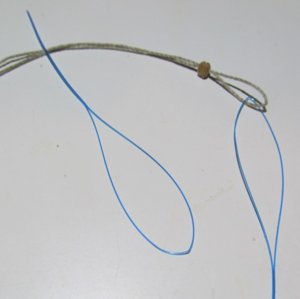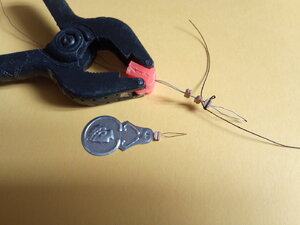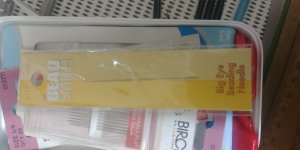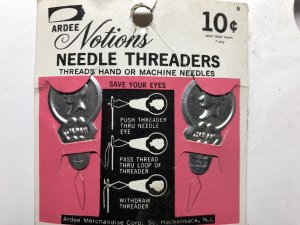-

Win a Free Custom Engraved Brass Coin!!!
As a way to introduce our brass coins to the community, we will raffle off a free coin during the month of August. Follow link ABOVE for instructions for entering.
-

PRE-ORDER SHIPS IN SCALE TODAY!
The beloved Ships in Scale Magazine is back and charting a new course for 2026!
Discover new skills, new techniques, and new inspirations in every issue.
NOTE THAT OUR FIRST ISSUE WILL BE JAN/FEB 2026
You are using an out of date browser. It may not display this or other websites correctly.
You should upgrade or use an alternative browser.
You should upgrade or use an alternative browser.
You don't split tiny 2mm blocks with this? I just use tiny micro drill bits on the archimedes drill on those and thread them with standard wire needle threaders. It's a two step process, but I don't waste those nice Falkonet blocks by breaking them into useless wood chunks.
At the drug store close to the toothpaste you can find Gun flossing hoops which I use to thread line through blocks. You push the stiff end through the block, put the line through the loop and pull on the stiff end as the line goes through the block. Won't work too well for 2 mm blocks, though. For them, the best way I've found is a little CA applied to the end if the line so only one thickness needs to go through the block.
the block. Won't work too well for 2 mm blocks, though. For them, the best way I've found is a little CA applied to the end if the line so only one thickness needs to go through the block.
 the block. Won't work too well for 2 mm blocks, though. For them, the best way I've found is a little CA applied to the end if the line so only one thickness needs to go through the block.
the block. Won't work too well for 2 mm blocks, though. For them, the best way I've found is a little CA applied to the end if the line so only one thickness needs to go through the block.Very good idea ..... will give it a tryAt the drug store close to the toothpaste you can find Gun flossing hoops which I use to thread line through blocks. You push the stiff end through the block, put the line through the loop and pull on the stiff end as the line goes throughView attachment 105600 the block. Won't work too well for 2 mm blocks, though. For them, the best way I've found is a little CA applied to the end if the line so only one thickness needs to go through the block.
I did not think of using CA glue to make a needle end of the "thread" through the block but instead use some Titebond original wood glue on my finger, being water soluble is easier to clean off. Not as fast as CA possibly but it works for my pace. PT-2
I did not think of using CA glue to make a needle end of the "thread" through the block but instead use some Titebond original wood glue on my finger, being water soluble is easier to clean off. Not as fast as CA possibly but it works for my pace. PT-2Very good idea ..... will give it a try
I have two types of CA: instant and a slower one that still wants to glue my fingers together and tough to remove when set. I don't need another layer of callouses on my fingers. I may give it a try though. Thanks for your experienced recommendation. PT-2
I use a medium thickness glue. Pull it through your fingers quite quickly then wipe your fingers on your jeans. You must however perfect an absolute air of innocence when explaining to your partner that you have no idea how glue got onto your jeans....
My own adhesive of choice for this is Tightbond. Being water soluble the cleanup of fingers and any thing else is very easy. The thread end is rotated with the same lay as the thread and when dry the tip is cut off at an acute angle for a good point. There are not right or wrong ways just personal choices. PT-2Running it through your fingers makes sure that you are not thickening the thread at all....
My local Tesco store sells needle threaders as a pack of three with a thimble. I have a lot of thimbles.
Fuse wire makes a good equivalent threader for situations where the item cannot be passed through a needle threader.
(E.g. on a bight, loop, of link of a chain). Double the wire round the cord or thread it through the end link of a chain.
Thread both free ends of the wire through the hole and pull.
Fuse wire makes a good equivalent threader for situations where the item cannot be passed through a needle threader.
(E.g. on a bight, loop, of link of a chain). Double the wire round the cord or thread it through the end link of a chain.
Thread both free ends of the wire through the hole and pull.
They work OK for larger blocks but 3mm and 2.5mm have not worked; so I use the glued fingers to twist the thread into a needle end and trim it at an angle. (extra cloth nearby for the fingers and not pants) PT-2My local Tesco store sells needle threaders as a pack of three with a thimble. I have a lot of thimbles.
Fuse wire makes a good equivalent threader for situations where the item cannot be passed through a needle threader.
(E.g. on a bight, loop, of link of a chain). Double the wire round the cord or thread it through the end link of a chain.
Thread both free ends of the wire through the hole and pull.
Block threading
The picture below shows a series of blocks threaded on a doubled length of fuse wire.
While thus restrained it is easy to tie on the strops - with or without a tail loop. (Production line processing!)
The blocks may be removed one-by-one after passing the relevant piece of running rigging through the loop in the wire.
Double blocks may need to be revisited with a needle threader.
The blocks shown are 3mm. The larger ones are even easier to process.

Aside: are block strops tarred or natural? My instruction sheets don't make this very clear.
The picture below shows a series of blocks threaded on a doubled length of fuse wire.
While thus restrained it is easy to tie on the strops - with or without a tail loop. (Production line processing!)
The blocks may be removed one-by-one after passing the relevant piece of running rigging through the loop in the wire.
Double blocks may need to be revisited with a needle threader.
The blocks shown are 3mm. The larger ones are even easier to process.

Aside: are block strops tarred or natural? My instruction sheets don't make this very clear.
I was wondering how to get the rigging through the block holes , But above explains it , using CA glue on the tip end and yes a kicker if I a hurry ,I tried and it works LOL ! a needle only to widen or clear the little holes for the rigging to pass through
I am glad that you found a very workable method. I just use aliphatic glue light TightBond with a drop of my finger to roll the thread, letting it dry before trimming the end at an angle. Gets lots of glue buildup during a night of rigging. I do use small files and drill bits to round out the entry and falls exit holes and grooves for a better thread form without squares. Now you have a good course before your bow. Rich (PT-2)I was wondering how to get the rigging through the block holes , But above explains it , using CA glue on the tip end and yes a kicker if I a hurry ,I tried and it works LOL ! a needle only to widen or clear the little holes for the rigging to pass through








